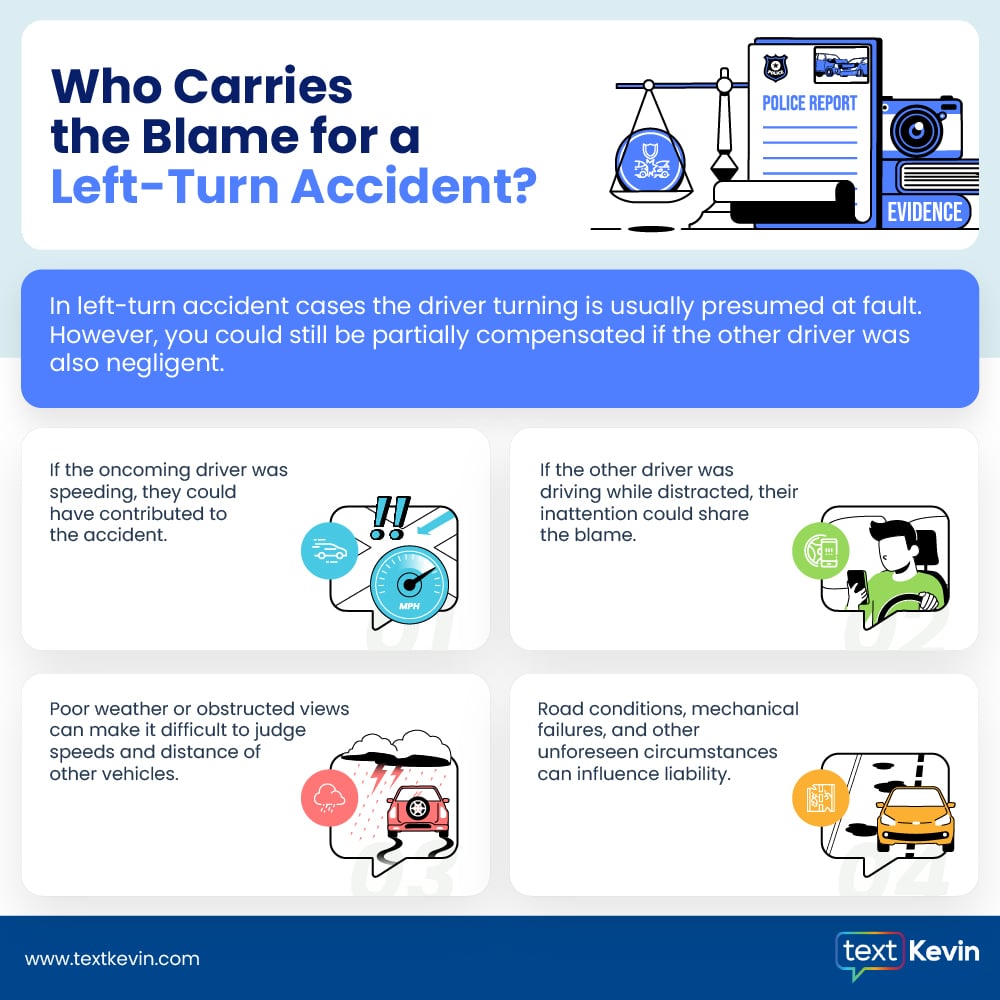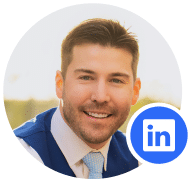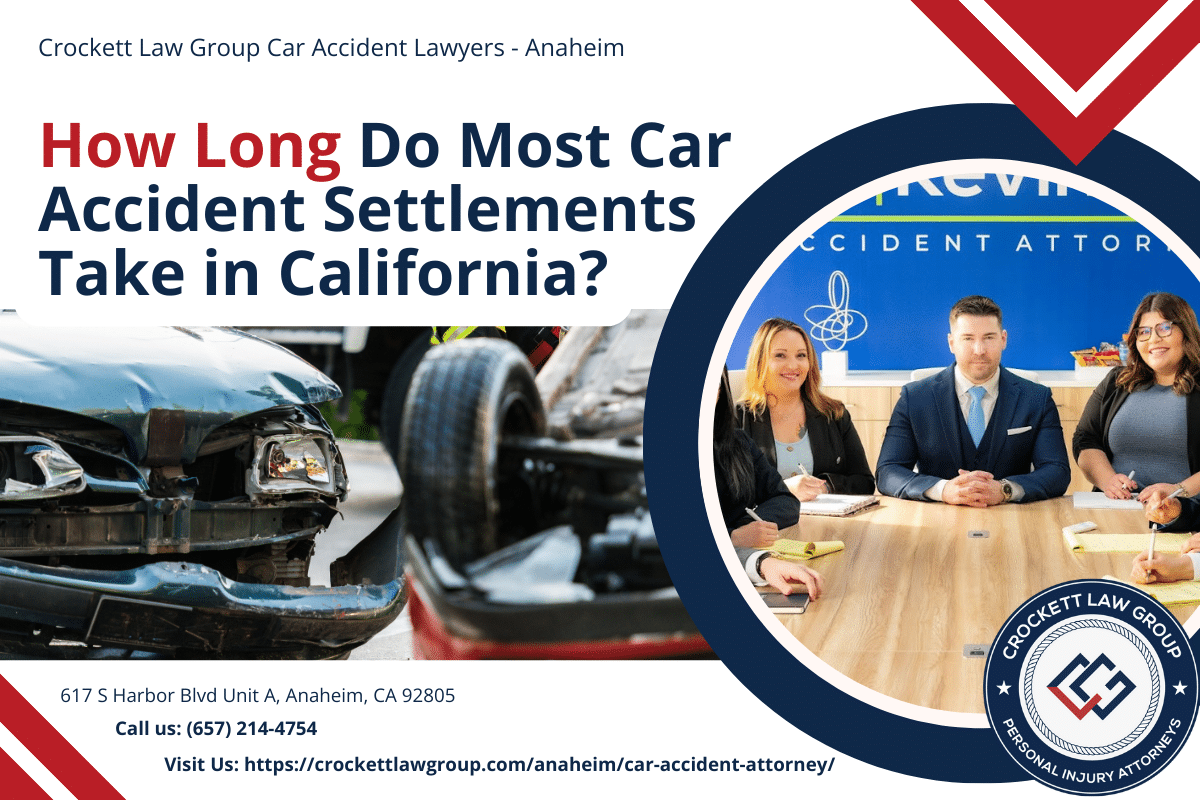Winning a left-turn accident case hinges on proving the other driver’s negligence and showing that their actions directly caused your injuries with solid evidence and expert legal guidance.
You’re patiently waiting at a green light, ready to turn left. As you carefully begin your turn, a speeding car barrels through the intersection from the opposite direction, colliding with your vehicle. The aftermath is medical bills, lost wages, and emotional trauma, and wondering if you can hold the other driver accountable.
Left-turn accidents are often caused by another driver’s negligence, such as speeding, running a red light, or failing to yield. This comprehensive guide will expound on these cases and provide strategies for building a solid car accident claim and defending yourself against a CVC 21801 ticket.
Key strategies for winning a left-turn accident case in California
Left-turn accidents can be complex and contentious, often involving disputes over who had the right-of-way. If you’ve been injured in such an accident, understanding the key strategies and evidence required to build a strong case is crucial for securing fair compensation.
Gather compelling evidence
Immediately after the accident, document everything you can. Take photos of the scene, including the position of the vehicles, traffic signals, any skid marks, and the damage to all vehicles involved.
Speak to any witnesses and get their contact information – their accounts can be crucial in proving fault. Obtain a copy of the police report containing valuable details about the accident. Finally, gather all medical records related to your injuries and treatment, as these will be essential in establishing the extent of your injuries. These might include:
- Traumatic brain injury
- Burn injuries
- Spinal cord injury
- In some tragic left-turn accidents, there could be occurrences of wrongful death.
If surveillance footage of the accident from nearby businesses or traffic cameras exists, secure a copy. This can provide irrefutable evidence of what happened.
Establish negligence
Under California Vehicle Code (CVC) Section 21801, proving the turn was safe falls on the driver turning left. To establish the other driver’s negligence, you’ll need to confirm the following:
- The other driver had a duty of care to yield the right-of-way to oncoming traffic close enough to constitute a hazard.
- They breached their duty by turning left when it was unsafe.
- Their failure to yield directly caused the accident and your injuries.
- As a result of the accident, you suffered quantifiable damages, such as medical bills, lost wages, and pain and suffering.
Proving these elements often requires a thorough analysis of the evidence, including witness statements, expert testimony, and accident scene reconstruction.
Seek legal representation
An experienced personal injury legal advisor specializing in car accidents can guide you through the process, gather and analyze evidence, negotiate with insurance companies, and represent your interests in court if necessary. They can also help you determine the full extent of your damages, including economic and non-economic losses.
Pro Tip
- Investigate the other driver’s record to check for any prior traffic violations or accidents that could indicate a pattern of negligent driving.
- Consider expert witnesses like accident reconstruction experts or medical professionals who can provide valuable testimony to support your case.
- Be prepared for settlement negotiations because insurance companies may offer a settlement to avoid going to trial. Allow your legal counsel to help you evaluate any offers and negotiate for fair compensation.
What Califonia law says about fault in left turn accidents
Left turns are a notorious source of confusion and conflict on California roads. Determining who’s at fault in a left turn accident often hinges on understanding a crucial piece of legislation: California Vehicle Code (CVC) § 21801.
This vehicle code section heavily burdens drivers making left turns or U-turns. It states that you MUST yield the right-of-way to all oncoming traffic close enough to pose a hazard. This means you are not just waiting for a gap but actively judging the speed and distance of oncoming vehicles to ensure a safe turn.
Violating CVC § 21801 isn’t just a matter of etiquette; it’s an infraction punishable by a traffic ticket and a point on your driving record. More importantly, it significantly increases the chances of causing a severe accident.
Who carries the blame for left-turn accidents?
In most left turn accidents, the turning driver is presumed to be at fault due to their obligation to yield. However, a fault isn’t always black and white. California’s pure comparative negligence law means that even if you made the left turn, you could still be partially compensated if the other driver was also negligent.
Here’s where the situation becomes complex, and help from a car accident professional comes in handy:
- If the oncoming driver was speeding, their negligence could contribute to the accident, even if you failed to yield.
- In distracted driving, where the other driver was texting or otherwise distracted, their inattention could share the blame.
- Visibility Issues due to poor weather or obstructed views can sometimes make it difficult to judge the speed and distance of oncoming traffic.
- Other Factors like road conditions, mechanical failures, and unforeseen circumstances can also influence liability.

How negligence per se strengthens your left-turn accident
In California, a powerful legal tool known as the “negligence per se” doctrine can play a pivotal role in establishing fault and liability.
Under California law, negligence is failing to exercise reasonable care and harming others. In the context of left-turn accidents, a driver who violates Vehicle Code 22100, which outlines the rules for proper turns, is considered negligent.
By establishing negligence per se, you gain a significant advantage in your personal injury claim. It simplifies the process of proving fault, as the court presumes the other driver’s negligence due to their violation of the law.
This presumption can make it easier to secure compensation for your medical expenses, lost wages, pain and suffering, and other damages resulting from the accident.
Tip
It’s important to note that California operates under a “pure comparative negligence” system. This means that even if you were partially at fault for the accident, you can still recover damages, but the amount you receive will be reduced based on your percentage of fault.
For example, if you were found 20% at fault for the accident, your compensation would be reduced by 20%.
Why investigation and legal representation matters in a left turn accident case
A thorough investigation is necessary to assess fault in a left-turn accident accurately. Evidence like police reports, witness statements, photos, and even accident reconstruction can help determine the sequence of events and each driver’s actions.
If you’ve been injured in a left-turn accident or even sustained catastrophic injuries, don’t assume you’re automatically at fault. We can analyze the evidence, apply the relevant laws, and negotiate with insurance companies to ensure you receive fair compensation for your injuries and losses.
Understanding California’s laws regarding left turns and seeking legal counsel when necessary can be your best defense in navigating the aftermath of a left-turn collision.
Note
Unprotected left turns, with no green arrow signal, are particularly prone to failure-to-yield accidents. It’s crucial to remember that you can only make a left turn when it’s safe to do so, even if you have the right of way. Misjudging the speed of oncoming traffic or failing to see a pedestrian can have devastating consequences.
Defending against a failure to yield ticket after a left turn violation in California
If you’ve received a ticket under CVC 21801 for failing to yield while making a left turn, you must understand the potential legal defenses available to you. Remember, proving fault in a left-turn accident is not always straightforward, and you have the right to challenge the citation.
Here are some common defenses that may apply to your situation:
Safe completion of the turn
This defense focuses on demonstrating that you did indeed yield to oncoming traffic and only proceeded with your left turn when it was safe to do so. You can provide evidence such as:
- Statements from passengers or bystanders who can corroborate your account of the incident.
- Video evidence from your dashcam footage clearly shows your yielding behavior and the other driver’s actions.
- Expert analysis to help determine the timing, speed, and distances involved in the accident, potentially supporting your claim of safe turning.
Absence of hazard
This defense argues that the oncoming traffic was not close enough to constitute a hazard when you initiated your turn. Based on the speed of the oncoming vehicle and your vehicle, you can argue that they were not a reasonable threat at your turn.
If weather conditions, road design, or other factors limited visibility, you could argue that it was reasonable for you not to see the approaching vehicle. In rare cases, you may have been forced to turn left due to an emergency. This defense requires you to prove that:
- You were facing imminent danger or a threat to your safety.
- Your actions were reasonable because your decision to turn left was a necessary and proportionate response to the emergency.
You have the right to defend yourself against a failure-to-yield ticket. Understanding your legal options can increase your chances of a successful outcome and avoid the negative consequences of an unfair citation.
Failing to yield in left turns has penalties and can impact your case
Penalties under California law come with a traffic ticket and hefty fines. Failing to yield while turning left (CVC 21801) will land you a traffic ticket with a base fine of $35. However, with additional penalty assessments and court fees, the total cost can easily surpass $200.
The violation adds a point to your DMV record, potentially increasing your insurance premiums. Additionally, accumulating too many points can lead to license suspension.
The Importance of proving you yielded
In a left-turn collision, your failure to yield can be used as evidence of negligence, shifting fault towards you and reducing potential compensation for your injuries. It may even lead to you liable for the other driver’s damages.
How to make a safe left turn in California
Left turns, while a typical maneuver, are often a source of confusion and accidents. Understanding the rules and techniques for safe left turns is crucial in California to avoid collisions and potential legal trouble. Here is how you make a left turn safely:
- Position yourself close to the center divider or into a designated left-turn lane. If there’s a two-way left-turn lane, enter it within 200 feet of the turn, yielding to any vehicles already in the lane.
- Signal and activate your left turn signal early, at least 100 feet before your intended turn. This gives other drivers ample notice of your intentions.
- Slow Down as you approach the intersection cautiously and come to a complete stop behind the limit line, crosswalk, or the edge of the intersection if there are no markings.
- Yield to oncoming traffic. Look left, right, and left again to ensure no oncoming traffic or pedestrians are crossing. Remember, pedestrians always have the right of way, even if crossing against a light.
- Turn when the path is safe and clear, smoothly turn into the left lane of the new road. Avoid cutting corners or turning too broad, which could obstruct other vehicles or pedestrians.
Take your time with the turn and wait for a safe gap in traffic, even if it means waiting through a few light cycles. In California, you may turn left on a red light only if you’re turning from a one-way street onto another one-way street and there’s no sign prohibiting the turn. Before turning, come to a complete stop, yield to any pedestrians or traffic with a green light, and proceed only when it’s safe.
Seek legal counsel for your left turn accident today
To successfully win a left-turn accident case, it’s crucial to demonstrate that you adhered to the law and yielded appropriately. If you’re involved in a left-turn accident, don’t assume that having the right of way automatically absolves you of responsibility.
Seeking legal counsel is important to protect your rights and understand the complex legal landscape surrounding left-turn accidents.










